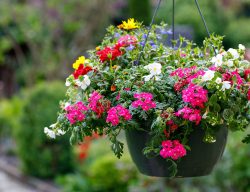By Laurel Aiello

Nothing says “home sweet home” like a pair of annual flower baskets hanging on either side of your front door. It’s a simple way to brighten up your porch and make a statement with a variety of colors, textures and shapes—an opportunity that only comes this time of year. Whether you’re shopping for premade annual hanging baskets or you’re designing them all on your own, here are some tips to get you started.
Know your light levels
Before combining different kinds of plants, make sure the ones you choose will survive where you plan to hang them. Most annual plants come with a tag that says “full sun” (six or more hours of direct sun), “part sun” (a few hours of direct sun) or “shade” (bright indirect light), meaning they won’t thrive in other levels of light. The south- and west-facing sides of the house are generally good spots for annuals that require full sun and can tolerate intense summer heat, whereas the east and north sides are ideal for plants that prefer less direct light.
That also means that plants with different light requirements won’t do well together in a hanging basket. Petunias need full sun, for example, so they will do much better with verbena or lantana than shade-loving begonias or impatiens. Other showy, sun-loving annuals that are commonly used in hanging baskets are geraniums, calibrachoa, bacopa, nemesia, and scaevola. Hanging baskets for shade often incorporate fuchsia (great for attracting hummingbirds), lobelia, impatiens, and all kinds of begonias.
Include thrillers, fillers and spillers
The plants at the center of your hanging baskets should be showy so that you can see them from a distance. Choose larger flowers in bright colors, like hot pink Supertunias for sun or bright orange Nonstop begonias for shade, then fill in the edges with something more subtle, like nemesia for sun or euphorbia for shade. “Spillers,” or vines that cascade over the edge, could include sweet potato vine for sun, vinca for part sun or creeping Jenny for shade (these will get long, so you may have to trim them periodically). Lesser-known vines are also an option, including dichondra and black-eyed Susan vine for sun and different varieties of ivy for shade.
Of course, your annual hanging baskets can also be monotone and feature only one type of plant that thrills, fills and spills all on its own. Popular choices that fill out nicely are bulbous fuschia varieties, double impatiens and tuberous begonias for shade and petunias, geraniums, Superbenas and calibrachoa for sun. Even different colors of the same plant work well together; for example, nurseries often combine different shades of petunias to add depth and dimension within a single color palate.
Experiment with different colors, textures and shapes
DIY annual hanging baskets can take on any color scheme and include as many different colors as you want. If you’re feeling patriotic ahead of Independence Day, for example, consider using red calibrachoa, white verbena and blue petunias in a sunny spot. Or if you prefer peachy tones for full sun, try a sunset-colored lantana surrounded by red Superbells calibrachoa. Those who prefer cooler tones for a shady spot might consider purple impatiens encircled in blue and white lobelia.
Different textures and shapes also create interest in hanging baskets. Don’t be afraid to mix some asparagus ferns into an annual basket for shade or add a larger sweet potato vine to a sunny basket. If you’re feeling adventurous, try an interesting plant you might not have heard of, like a fuzzy red chenille plant for sun or a tubular blue torenia for shade. You can even incorporate some houseplants, like rex begonias or tradescantia, for a more unique look. Some even use quirky grasses, like the short and curly corkscrew rush (a juncus variety) or a little bunny tail grass for an extra bit of fluff in the sun.
Remember, the end goal is to create something you love and have fun doing it, regardless of what it looks like compared to your neighbor’s displays. The joy of DIY annual hanging baskets is that they are in many ways a living art project—an expression of your creativity that will last all summer long.
Originally published on May 30th, 2025.
